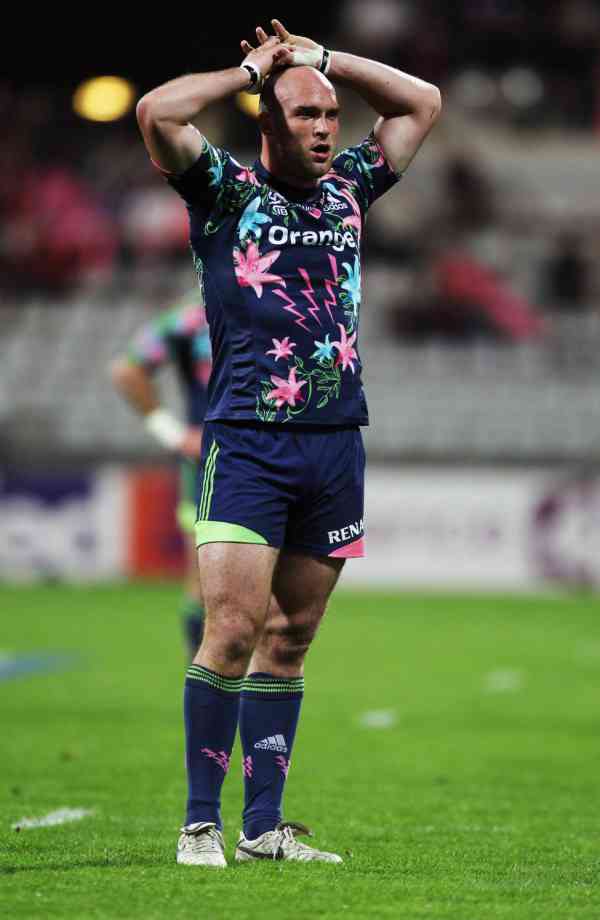Antoine Burban’s rugby career was one marked by relentless commitment and a passion that propelled him through nearly two decades at Stade Français. However, behind the accolades and physical feats lay a deeper, unseen struggle that has persisted long after his retirement in 2022. His journey, chronicled poignantly through the eyes of his partner, Lucie, unearths the silent consequences of rugby’s brutal impact on the human body and mind. This narrative unfolds beyond stadium roar and cheering crowds, exposing the delicate nexus between sport, health, and family life that few athletes dare to confront.
Understanding the Physical and Emotional Toll of Rugby on Antoine Burban
Antoine Burban’s tenure as a flanker for Stade Français spanned an impressive 257 professional matches, during which he earned two Brennus trophies (2007 and 2015) and a Challenge Cup in 2017. His dedication to the game was relentless, exemplifying qualities that rugby enthusiasts admire: toughness, resilience, and tactical awareness. Yet the physical price he paid remains a vital and heartrending part of his legacy, demonstrating the profound impact of high-contact sports on the health and well-being of athletes.
Throughout his career, Burban experienced between 15 to 20 head impacts, a staggering tally even among rugby players. These concussions and sub-concussive blows are now understood within sports medicine as significant risks for long-term neurological issues. Lucie, his partner, describes a startling transformation in his personality as a result — moments of uncontrollable anger, unexpected outbursts, and psychological strain that gradually chiseled away at their family dynamics. Understanding this transformation requires a comprehensive exploration into what repetitive head trauma does to the brain.
Modern rugby gear brands such as Gilbert and Opro have invested heavily in protective equipment designed to mitigate injury risk. Players are outfitted with advanced helmets and mouthguards, including those from Canterbury and Kukri, to offer enhanced safety during tackles and scrums. Despite these advancements, the nature of rugby — fueled by relentless physicality — means risks persist. Protective gear can reduce but not eliminate the trauma sustained from high-impact collisions, particularly those targeting the head and neck.
In Antoine’s case, these injuries impacted not only his playing days but stretched into his personal life, shaping interactions and emotional health. Lucie recounts:
- Frequent episodes of excessive anger and irritability
- Episodes where the family felt unsure “which person they had in front of them”
- Children being exposed early to the explanation that “Dad reacts like this because of his head injuries”
These are powerful evidence of the far-reaching consequences concussions can have beyond the pitch.
The complexity of rugby’s impact doesn’t end with immediate physical effects. The long-term mental health challenges associated with repeated concussions mimic symptoms observed in conditions like Chronic Traumatic Encephalopathy (CTE). This underscores why many players, like Burban, feel the weight of invisible wounds long after the crowd noise has faded.
The psychological aftermath of rugby injuries is an often overlooked but critical facet of the sport’s impact. In Antoine Burban’s case, the repeated head traumas triggered changes in behavior, emotional stability, and cognitive function—an evolution deeply distressing for both himself and his family.
Lucie’s testimony reveals raw, unfiltered insights into the mental landscape shaped by these injuries. She vividly describes how moments of explosive anger and confusion would make the day-to-day life arduous. This volatility is well-documented in sports medicine literature as characteristic of post-concussion syndrome, in which the brain struggles to regulate emotions and control impulses. Coupled with the frustration of physical pain and the loss of a former self, it creates a formidable challenge.
Moreover, Lucie’s recounting surfaces a critical dilemma: the invisible nature of brain injuries. Unlike visible bruises or broken bones, the internal disruptions caused by rugby-related concussions often leave families grappling with uncertainty. Lucie expresses how she could see that Antoine was suffering yet struggled to comprehend the inexplicable mood swings and behaviors. This invisible injury compounds the emotional toll on both the athlete and their loved ones.
Rugby World has increasingly highlighted research advocating for improved mental health support and concussion protocols. The sport’s governing bodies and clubs are pressed to implement comprehensive strategies that extend beyond the field, integrating continued monitoring, counseling, and rehabilitation support for former players. The story of Antoine Burban testifies to the urgent need for this holistic approach.
To contextualize these challenges, consider this list of psychological effects commonly reported by athletes succumbing to repeated concussions:
- Emotional instability with frequent mood swings
- Depression and anxiety exacerbated by uncertainty about the future
- Memory loss and difficulty concentrating on routine tasks
- Sleep disturbances impacting daily functionality
- Feelings of isolation due to reduced social engagement
These symptoms often persist post-retirement, making adjustment to life outside professional sports an uphill battle for many.
Conversely, brands such as Under Armour and Puma, though traditionally focused on sporting apparel, have begun supporting awareness campaigns about safer practices in rugby, underscoring the collective responsibility of the industry to protect athletes physically and mentally.
[embedded content]
| Psychological Effects | Description | Potential Consequences |
|---|---|---|
| Emotional Instability | Frequent unexplained mood swings, irritability | Strained personal relationships, social withdrawal |
| Memory Loss | Difficulty recalling recent events or focusing | Challenges in daily tasks and professional adaptation |
| Depression | Feelings of hopelessness and low mood | Risk of withdrawal, reduced quality of life |
| Sleep Disorders | Insomnia or fragmented sleep patterns | Fatigue impacting mental and physical health |
Antoine Burban’s Retirement Decision: A Turning Point Marked by Self-Preservation
By June 2022, after 16 years of exceptional dedication, Antoine Burban made the pivotal decision to retire from professional rugby. This conclusion to his career was not merely a consequence of contract expiration but an act grounded in deep self-awareness and the urgent need to safeguard both his mind and body.
He publicly stated, “Mon corps et ma tête ont dit stop,” reflecting a clear and powerful recognition by his body and mind that continuing rugby at a professional level was unsustainable. This phrase encapsulates the physical and psychological exhaustion that many veteran players experience but rarely voice with such straightforward honesty.
Analyzing Burban’s decision reveals broader trends seen among rugby players facing retirement:
- The accumulation of injuries pushes athletes to prioritize health over continuing fame
- Growing awareness of chronic conditions such as concussions and their long-term impact
- Desire to protect personal relationships and regain control of emotional well-being
- The challenge of transitioning from active sports to alternative careers or lifestyles
This pivotal life change often reflects a conflicted process, in which athletes rebuild their identities beyond the sport that defined much of their lives.
Brands deeply connected to rugby, including Nike and Mizuno, support elite athletes not only with equipment but also through programs aimed at preparing players for life after the game. Such initiatives focus on career transition, mental health, and financial planning, acknowledging that retirement requires holistic readiness rather than a singular focus on athletic prowess.
Moreover, Burban’s story resonates with the realities faced by many notable rugby figures who have navigated a similar path. For those who have followed his playing days, from his debut in 2006 to becoming a key flanker succeeding Rémy Martin, his eventual retirement reflects a universal truth: the human body and psyche have limits that even the strongest athletes must respect.
Family Life and the Ripple Effects of Rugby’s Hidden Wounds
The emotional and physical toll on Antoine Burban extended far beyond his own experience, deeply affecting the fabric of his family life. Lucie’s testimony paints a vivid picture of the daily challenges and sacrifices endured by families whose loved ones suffer the long-lasting aftermath of sports injuries.
Antoine’s personality shifts—marked by impulsive anger and emotional fragility—created moments of tension and a pervasive sense of unease within the household. Lucie recounts how this environment required immense patience and understanding, forcing her and their children to adapt to new norms, including explaining the reasons behind Antoine’s behaviors:
- Open conversations with their children about the nature of head injuries and behavior shifts
- Developing coping strategies to manage emotional volatility and stress
- Seeking external support, such as counseling, to address family dynamics
The journey towards acceptance was not linear. The couple had to confront profound questions, including the justification of risking lives for sport, a sentiment Lucie expressed with poignant honesty: “It’s incomprehensible to put one’s life at risk for a game.” This reflects a broader debate evolving in rugby circles, where player welfare is increasingly prioritized to prevent tragic consequences.
Within the sphere of rugby equipment and clubs, the influence of brands like Puma and Adidas continues not only in performance apparel but also in health advocacy, leveraging their global platforms to raise awareness about safety, injury prevention, and the mental health impacts on players and families alike.
| Family Impact Area | Challenges Faced | Support Strategies |
|---|---|---|
| Emotional Turbulence | Sudden anger outbursts and mood swings | Open dialogues, emotional coaching |
| Child Awareness | Understanding parental behavior changes | Age-appropriate education on injuries |
| Family Stress | Daily uncertainty, tension | Therapeutic counseling, community support |
Ultimately, Antoine Burban’s story is a clarion call within the rugby world—to acknowledge, address, and heal the invisible wounds that athletes bear, and to support their reintegration into family life with dignity and compassion.
Advancements and Challenges in Rugby Safety: Protecting Future Generations
The legacy of Antoine Burban’s career and retirement shines a spotlight on the evolving landscape of rugby safety in 2025. While the sport continues to be one of the most physically demanding team sports, ongoing innovations in protective equipment and safety protocols seek to reduce the risk of catastrophic injury.
Leading the advancement are companies like Gilbert, Opro, and Canterbury, who push technological boundaries to enhance headgear, scrum caps, and mouthguards. Alongside these, names such as Nike and Mizuno engage in research partnerships to blend performance apparel with injury mitigation technologies. This integrated approach aims to protect vital areas rigorously while maintaining player comfort and agility.
Rules modifications introduced in recent years have also played a crucial part:
- Stricter penalties for high tackles aimed at the head
- Implementation of temporary suspensions during concussion assessments (HIA protocols)
- Increased training for referees on player safety and collision adjudication
- Mandatory education sessions for players and coaches on concussion awareness
Such measures have collectively contributed to a reduction in severe head injuries during matches, signaling a positive shift in rugby’s safety culture.
Despite these efforts, challenges remain:
- The sport’s inherent physicality means zero risk is impossible
- Not all players report symptoms due to competitive pressures or stigma
- Long-term effects like those experienced by Antoine remain difficult to predict or prevent fully
- Resource disparities limit access to comprehensive post-injury care in many regions
The rugby community, including fans following dramatic and historic matches highlighted in Rugby World, continues to demand better support systems for players. It recognizes that greatness in the sport must go hand in hand with sustainable health and safety policies.
| Safety Innovation | Organizations/Brands Involved | Impact on Player Welfare |
|---|---|---|
| Advanced Protective Gear | Gilbert, Opro, Canterbury | Reduced severity of head injuries and concussions |
| Concussion Protocols | International Rugby Bodies, Clubs | Early detection and removal from play to prevent aggravation |
| Rule Adjustments | World Rugby, Referees | Increased safety via stricter enforcement of foul play |
| Player Education | Under Armour, Adidas, Rugby Associations | Improved awareness and reporting of injury symptoms |
Looking forward, the rugby world continues to balance the thrill of the game with the imperative to safeguard those who play it. Stories like Antoine Burban’s not only inspire respect but also fuel momentum for a safer, more compassionate future in rugby.


